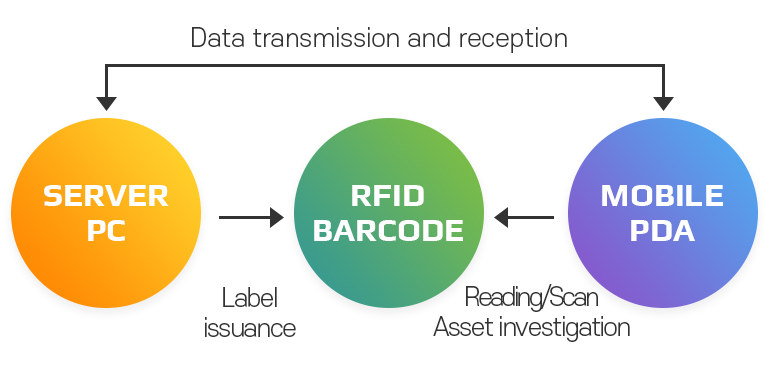ASSET MANAGEMENT SYSTEM
Overview
AMS (Asset Management System) is an optimal asset management system that easily manages assets using various equipment. It is possible to manage assets more efficiently and conveniently by utilizing the electronic tracking function for assets using next-generation information devices. RFID and various barcode devices (industrial PDA, Android PDA, barcode printer, etc.) can be selected according to the desired system, and work can be performed by linking existing asset information.
Features and Advantages
- Computerization of asset data increases work efficiency.
- Easier due diligence with mobile PDAs.
- Real-time asset status at a glance.
- Integration of reality and information is possible.
- Easy to manage historical information such as asset movement/rental/disposal.
- According to the environment, it is possible to use conveniently by customized production for each customer.
System Process


- 01 Create and attach asset classification tags with barcode or RFID
- 02 Asset registration using mobile PDA
- 03 Handling / loan / disposal of registered assets
- 04 Query the history of processed assets
- 05 Asset status management through due diligence survey
System Configuration
-
Standard information management
- Asset registration
- Location registration
- Department registration
- User management
-
Barcode issuance
- Asset barcode issuance
- Location barcode issuance
-
Equipment management
- Equipment registration
- Equipment Status
-
Inventory adjustment
- Inventory adjustment
- Asset transfer
- Asset sale / disposal / repair management
-
Data transmission
- Asset information transmission
- Location information transmission
- Department information transmission
- Asset transfer transmission
-
Data reception
- Asset reference reception
- Asset transfer reception
- Asset disposal reception
- Asset sale reception
-
Status inquiry
- Asset status inquiry
- Repair status inquiry
- Disposal sale status inquiry
- Reference status inquiry
Introduction Effect
Management strategy aspect
- • Securing transparency in corporate accounting through statistical identification of physical assets
- • Effective management of holding assets, such as preventing duplicate investment in fixed assets, and predictive management from the manager's side due to fixed asset management functions
Management operation aspect
- Quickly grasp the current status of assets
- Enhance the convenience of management such as receipt, transfer, disposal, and rental
- Increased convenience in processing statistics of assets
- Fast, convenient and accurate check of property
- Increased efficiency through management using barcodes
- Shortening the time required for asset management

